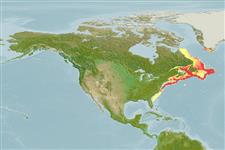Classification / Names
Common names from other countries
Main reference
Size / Weight / Age
Max length : 42.0 cm NG male/unsexed; (Ref. 58426)
Environment
Marine; benthopelagic; non-migratory; depth range 90 - 1500 m (Ref. 40643), usually 360 - 800 m (Ref. 1371)
Climate / Range
Temperate, preferred ?; 61°N - 24°N, 81°W - 40°W
Distribution
Western Atlantic: Canada to straits of Florida, found in the outer continental shelves and slopes, but not abundant to south of Cape Hatteras.
Countries | FAO areas | Ecosystems | Occurrences | Introductions
Short description
Dorsal
spines
(total): 0;
Anal
spines: 0. Dorsal fin with an extremely elongated ray, its length longer than head length. Longest pelvic-fin ray reaching beyond the posterior end of the anal-fin base. Olive on sides, belly pale; the margins of the dorsal, caudal and anal fins darker.
IUCN Red List Status (Ref. 115185)
Threat to humans
Harmless
Human uses
Fisheries: of potential interest
Tools
Special reports
Download XML
Internet sources
Estimates of some properties based on models
Phylogenetic diversity index
PD50 = 0.6255 many relatives (e.g. carps) 0.5 - 2.0 few relatives (e.g. lungfishes)
Trophic Level
3.2 ±0.0 se; Based on diet studies.
Resilience
Low, minimum population doubling time 4.5 - 14 years (Preliminary K or Fecundity.)
Vulnerability
High to very high vulnerability (67 of 100)
Price category
